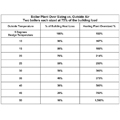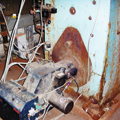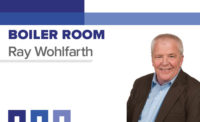How many boilers does it take to keep occupants comfortable?

|
|
Table 1. Boiler plant over sizing vs. outside air. Photo credit: Ray Wohlfarth |
Growing up with a red-haired, Irish mother, I had to learn all the Irish superstitions. For example:
-
Never cross a person on the stairs in a house.
-
If you spill salt, throw some over your shoulder.
-
Never open an umbrella inside a house.
-
Never place shoes on a table.
- Always give a coin to every stranger you meet on New Year’s Day.
When I asked her about these, I was told that neglecting these rules would bring bad luck to the person or the family, sometimes for years. No other explanation was ever given. These have been passed down from generation to generation without question.
Do we do the same thing when designing a boiler room?
How many boilers should we use in a boiler room project? One, two or several? Let’s explore the pros and cons of each.
The one-boiler argument
Some people believe that one boiler should be adequate. After all, many buildings used one boiler for years. The old single boiler worked well for years because parts were accessible locally for the older boilers. Most service calls involved replacing a thermocouple, gas valve or control. These were available at the local supply house.
However, most of the newer boilers use proprietary parts only available from the manufacturer. Good luck finding that part on a Friday afternoon. In addition, a single boiler will be grossly oversized for the majority of the winter and will cycle constantly. Cycling will cause more frequent breakdowns. If you are designing for or installing a single boiler, the building owner should consider purchasing some common spare parts to stock. This could reduce downtime and make a happy client.
We had a client with a failed inducer fan on his boiler on a Friday afternoon. No one stocked the part and we had order it from the factory. It arrived on Monday. Have you ever noticed how cranky people get when they have no heat for a weekend?
How about two boilers?
For years, two boilers have been the staple of the commercial boiler room. When designing a boiler room, we size the heating plant to be greater than the heat loss of the building, obviously. The question is, “How much larger?”
Let’s consider a hypothetical building with a heat loss of 1 million Btuh at the design temperature. If we use two boilers, we have to split the heating load between the two boilers. Some manufacturers suggest that each boiler should be sized for 50% of the load. In this scenario, each boiler would be sized for 625,000 Btuh input and 500,000 Btuh output.
Most designers are hesitant to have two boilers sized that close in case one of the boilers breaks down. When sized at 50% each, one boiler could handle the load when the outside temperature is above 34° F. If the outdoor temperature is below that, the lone operating boiler cannot keep up and the inside temperature will drop. The speed at which the building loses heat depends on the outside air temperature and the building shell.
In most instances, the designers will size each boiler for 75% of the load. In our fictional boiler room, each boiler will be sized for 937,000 Btuh input and 750,000 Btuh output. This will assure that the building will heat safely with one boiler down to about 17° F. The designer feels good and the owner has heat.
I contend that this is a disservice to the owner. On the coldest day of the year, our heating plant will be sized at 150% of the heating load and the oversized percentage will grow exponentially as the outdoor temperature rises, as seen in Table 1. That means our boilers will be 50% larger than they should be. This causes a ripple effect in the whole project. In addition to the boilers being oversized by 50%, everything else will be 50% larger including the pumps, combustion air openings, expansion tank, flue piping, chimney, gas piping, pipe insulation, electrical and system piping.
As you can imagine, the price for this project has just jumped dramatically. In addition, the maintenance will be higher for an oversized heating plant due to excessive cycling. In the above example, you would be hard pressed to find a boiler sized at 937,000 Btuh, so you would have to choose the next larger size boiler, which would most likely be 1 million Btuh with a rated output of 800,000 Btuh. Our heating plant is now 60% larger than we need.
Many installers will argue that modulating burners will reduce the boiler cycling. In the above example, the typical boilers will have a 3-to-1 turndown. That means the burner will be able to drop to 33% of its firing rate. Combined, the two heating boilers will have a 6-to-1 turndown, meaning the heating plant will be able to drop to about 309,000 Btuh input or 30% of the building load.

|
|
Maintenance will be higher for an oversized heating plant due to excessive cycling. Photo credit: Ray Wohlfart |
The modular boiler plant
Now, consider a modular boiler plant. In this example, I will use four boilers each sized for 25% of the load. Each boiler will be sized for 313,000 Btuh input and 250,000 Btuh output. Our heating plant will be sized for the load of the building. If one boiler fails, the building will still have 75% backup like the two-boiler plant, but the boiler plant will be 33% smaller. In addition to having a smaller boiler plant, our pumps, combustion air louver, flue, piping, etc., also will be 33% smaller.
The maintenance costs will be reduced, as will the operating costs because the system will be able to track the heat loss of the building better than two larger boilers. If we use modulating burners on this project, the system turndown will be 12 to 1, double the turndown of the two-boiler plant. The heating plant will be able to drop to about 103,000 Btuh input or 10% of the heating load. If you use more than four boilers, your seasonal efficiency is even greater.
Oh, one more thing: If you meet a magpie or a cat with a limp while you’re on a trip, it is bad luck.


